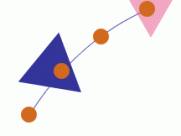Posture
Advantages of Neutral Posture
- Minimize injury risk
- Minimize structural changes (e.g., deformities)
- Allows for optimal muscle and organ function
Impaired Posture
The supervising PT may indicate "impaired posture" in a patient problem list and include goals related to posture (static and dynamic) in the plan of care.
For example, a patient with a medical diagnosis (pathology) of osteoporosis may present with impaired posture (increased thoracic kyphosis), which impacts pain and endurance for standing and walking.
Treatments for impaired posture include effecting a change in muscle length and strength and adapting for fixed, structural changes.
Muscles change length and muscle fiber type changes over time due to habitual postures, under use and misuse of structures. Shortened muscles become stiffer, less likely to respond to stretch, and the cycle continues.
A little asymmetry is normal. For example, in standing the dominant hand (i.e., left or right handed) is typically lower with reference to the acromion than the non-dominant hand. This is generally attributed to more developed (i.e., larger) muscles on the dominant side. This can then be compensated for by a higher pelvis on the non-dominant side.
Many large muscles cross multiple joints. Therefore, an over-lengthened or shortened muscle can influence the resting postions throughout the spine, pelvis and extremities.
Common faulty postures include: kyphosis-lordosis, sway back, and flat back
Active Learning: See if you can apply your knowledge of anatomical planes and observational skills to describing changes at the spine, head and lower extremity
Click here for an example of how posturography is used with tablet applications (e.g. PostureScreen) to assist in assessing posture. How would you document your observations of these postural asymmetries?
toc | return to top | previous page | next page




